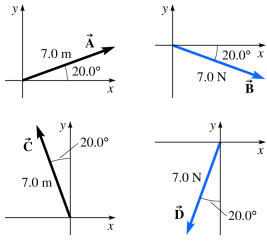 |
| 1 |  | 
Give an example of an object whose acceleration is (1) in the same direction as its velocity, (2) opposite its velocity, and (3) perpendicular to its velocity. |
|  | |
|
|
 |
| 2 |  | 
Can a body in free fall be in equilibrium? Explain. |
|  | |
|
|
 |
| 3 |  | 
Explain how to combine two displacement vectors of magnitudes 3L and 4L so that the resultant vector has magnitude (a) L; (b) 7L; (c) 5L. |
|  | |
|
|
 |
| 4 |  | 
The pilot of a small plane finds that the airport where he intended to land is fogged in. He flies 55 miles west to another airport to find that conditions there are too icy for him to land. He flies 25 miles south and is finally able to land at the third airport. (a) How far and in what direction must he fly the next day to go directly to his original destination? (b) How many extra miles beyond his original flight plan has he flown? |
|  | |
|
|
 |
| 5 |  | 
Vector A has magnitude 4.0 units; vector B has magnitude 6.0 units. The angle between A and B is 60.0°. What is the magnitude of A + B? |
|  | |
|
|
 |
| 6 |  | 
Vector a has components ax = -3.0 m/s2 and ay = +4.0 m/s2. (a) What is the magnitude of a? (b) What is the direction of a? Give an angle with respect to one of the coordinate axes. |
|  | |
|
|
 |
| 7 |  | 
Find the x- and y-components of the four vectors shown in Fig. 4.34.
 <a onClick="window.open('/olcweb/cgi/pluginpop.cgi?it=gif::Fig. 4.34::/sites/dl/free/0070524076/57987/fig4_34.gif','popWin', 'width=NaN,height=NaN,resizable,scrollbars');" href="#"><img valign="absmiddle" height="16" width="16" border="0" src="/olcweb/styles/shared/linkicons/image.gif">Fig. 4.34 (7.0K)</a>Fig. 4.34 <a onClick="window.open('/olcweb/cgi/pluginpop.cgi?it=gif::Fig. 4.34::/sites/dl/free/0070524076/57987/fig4_34.gif','popWin', 'width=NaN,height=NaN,resizable,scrollbars');" href="#"><img valign="absmiddle" height="16" width="16" border="0" src="/olcweb/styles/shared/linkicons/image.gif">Fig. 4.34 (7.0K)</a>Fig. 4.34 |
|  | |
|
|
 |
| 8 |  | 
Vector b has magnitude 7.1 and direction 14° below the +x-axis. Vector c has x-component cx = -1.8 and y-component cy = -6.7. Compute (a) the x- and y-components of b; (b) the magnitude and direction of c; (c) the magnitude and direction of c + b; (d) the x- and y-components of c - b. |
|  | |
|
|
 |
| 9 |  | 
(a) In Example 4.6, if the movers stop pushing on the safe, can the frictional force hold the safe in place without having it slide back down? (b) If not, what force needs to be applied to hold the safe in place? |
|  | |
|
|
 |
| 10 |  | 
A car travels east at 96 km/h for 1 h. It then travels north at 128 km/h for 1 h. (a) What is the average speed for the trip? (b) What is the average velocity for the trip? |
|  | |
|
|
 |
| 11 |  | 
A particle experiences a constant acceleration that is south at 2.50 m/s2. At t = 0, its velocity is 40.0 m/s east. What is its velocity at t = 8.00 s? |
|  | |
|
|
 |
| 12 |  | 
An airplane has a velocity relative to the ground of 210 m/s toward the east. The pilot measures his airspeed (the speed of the plane relative to the air) to be 160 m/s. What is the minimum wind velocity possible? Why is this the minimum velocity? |
|  | |
|
|
 |
| 13 |  | 
An airplane is traveling from New York to Paris, a distance of 5.80 × 103 km. Neglect the curvature of the Earth. (a) If the cruising speed of the airplane is 350.0 km/h, how much time will it take for the airplane to make the round-trip on a calm day? (b) If a steady wind blows from New York to Paris at 60.0 km/h, how much time will the round-trip take? (c) How much time will it take if there is a crosswind of 60.0 km/h? |
|  | |
|
|

